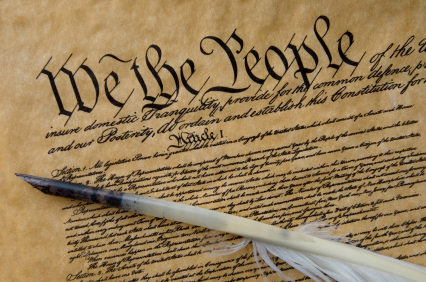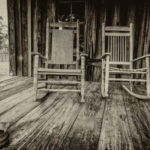Wherein I respond to the federal mandate to “celebrate” Constitution Day. The text is taken from a lecture I gave at Northwood University, co-sponsored by ISI and the Jack Miller Center.
The question before us, “Whose Constitution Is It?” presumes various parties that want to lay claim to the Constitution, which in turn would assume that, whatever else their differences, these parties largely regard the Constitution as a success, having created a legacy for itself that is worthy of claiming.
But what sort of success is being claimed, and do the parties agree on what constitutes a successful Constitution? We can imagine a variety of items being offered up as evidence of “success”:
- The American Constitutional order has survived for 224 years. In the annals of democracy, this is no mean feat.
- The American Constitution remains the most imitated Constitution in the world today.
- Americans enjoy, comparatively speaking, high degrees of personal liberty and material well-being.
- Political conflicts are so routinely resolved without resorting to violence that we simply assume that this is the way things ought to be done.
- The Constitution has demonstrated remarkable flexibility in responding to changing historical circumstances, particularly given the rapidity and complexity of those changes.
- After the travails of the modern world played themselves out, through revolution, ideological conflict, and world wars, America was left standing as the world’s lone superpower, achieving the greatness of its original promise.
- No compelling moral voice can be found in politics that does not couch itself in the principles of ordered liberty as embodied in the American Constitution.
Others may find fault with America, but typically won’t blame the Constitution for those faults. For example, one might argue that America displays the following pathologies:
- An overweening military empire that is bankrupting the country both financially and morally, as is evidenced by the pictures from Abu Ghraib.
- A massive federal debt that has made the threat of economic collapse and chaos not only greater but also more imminent.
- An intrusive nanny state that increasingly directs the energies and actions of the average American, performed by a centralized and depersonalized bureaucracy.
- A legislature with historically low levels of public respect, resulting largely from the inability of its members to work amicably together.
- A presidency that constantly gets consumed with that which it was nourished by: namely, the expectations it generates for itself.
- A public space which strikes many for its abuse of liberty rather than the extent of liberty, leading to a coarsened and debased culture that is less than worthy of our respect and best energies.
- A vacating of the middle class, and ever-increasing income inequality.A weakening of all non-governmental or non-federal institutions, ranging from the small units of family life to the larger units of state governments.
Even these skeptics, however, would likely see these failings as an abandonment of the Constitution rather than resulting from inherent problems with the Constitution itself. It is a rare critic who will attribute our current social and political problems to design flaws in the Constitution, and certainly an audacious one who spends Constitution Day exploring this very possibility.
While the Declaration of Independence may be America’s Sacred Scripture, the Constitution is our Torah, and carries with it a sort of quasi-divine authority validated by years of success and celebration. Many of those present at the Convention referred to its formation as a “miracle” which emanated from the hand of divine providence. Benjamin Rush concluded that the Constitution was “a gift from heaven” just as much from the hand of God as the parting of the Red Sea or the granting of the Ten Commandments.
Such claims certainly go a long way toward legitimating the authority of the Constitution, but they obscure the reality of the Constitution’s formation, and cast completely in the shadows those who resisted the document, seeing in it not the benevolent finger of Providence but rather the artful designs of the ambitious and the proud. I think in order to restore the Constitution to its proper proportions it is worth reflecting on some of these opponents, and reflecting on the reasons why they (apparently) went down to defeat. There were, after all, those who doubted the Constitution could accomplish what its proponents believed it could, and their voice is well worth listening to even now. Maybe especially now.
We typically refer to the opponents of the Constitution as “Anti-Federalists,” an unfair characterization that treats an eclectic but brilliant group of thinkers simply by what they didn’t like. It gives no argument for what they affirmed. Most fundamentally, they affirmed the moral proposition that individuals were most closely bound to those closest to them, and that government could only be just and protective of liberty when exercised among small homogeneous populations that attended to the formation of virtue among its citizens. They stressed government as a voluntary attachment; that is to say, that government could only be kept within its proper sphere and remain accountable if it was immediately connected to the lives of the people. If such immediacy were removed, the principle of attachment would devolve to force or coercion, thus leading incrementally but increasingly to a despotism that would attenuate the duties of citizenship and weaken the natural bonds between human beings.
In the world of the town and village, life was largely regulated by principles of mutual respect, honor, and charity. Individuals and government officials could rightly and fairly modulate the demands of justice by taking account of individual circumstances. A deep sense of trust held these communities together, and acted as the glue for a well-ordered and harmonious society (that is, not just between individuals, but between different social units). They believed that extending the sphere of government would create distrust and corrode the virtues associated with patriotism, citizenship, and action.
The Federalists recognized this, most famously James Madison in Federalist Paper #10. While the Anti-Federalists believed that distrust resulted from expanding social life beyond its proper boundaries, Madison argued that it was “sown in the nature of man.” As a result, faction would always be the problem of political life, for human beings were naturally self-interested and contentious. Madison’s well-known solution was to turn faction upon itself by creating a larger polity encompassing more factions that would check each other. For a small society “admits of no cure for the mischiefs of faction,” with the result that smaller republics “have been as short in their lives, as they have violent in their deaths.” A larger polity would stabilize public order and create a more efficient, and thus more just, government by protecting against majority factions. The key, for Madison, lay in his inversion of Anti-Federalist virtue, for while the former thought trust essential to a humane order, Madison believed that “unjust or dishonourable purposes” would always be checked by distrust, the fomentation of which improved political life.
It is not hard to see why the Anti-Federalists would look skeptically at such claims. In a dog-eat-dog social world predicated on anonymity and disconnectedness to place, individuals would feel less connected to their government, the actions of government would be less transparent, and the cause of liberty would be undermined by the space opened up for the most ambitious. Ambition might be made to counter ambition, but only if all were equally ambitious. Most persons preferred to lay in the shade of their own fig tree and enjoy the fruits of their own vines. While they reposed, the most unscrupulous among us would angle for power and would ultimately take a fig here or tax a vine there in order to fund their ambitions, which typically involved the longing for glory. (The Anti-Federalist pseudonyms such as Brutus and Cato invoked for readers the resistance to Rome’s quest for earthly glory.)
In this context we see why many of the Anti-Federalists regarded religion as so important for the formation of a free society, for it accepted the claim that glory is not of this world, and that the search for glory emanated from the sin of pride. The desire for glory would require a large and expensive military to accomplish its aims, and the formation of such necessarily devalued the virtues of independence. Indeed, many of them believed that the apparent problems of the 1780’s that led to the Philadelphia Convention resulted not from inherent weaknesses of the Articles of Confederation but rather from deficits of social capital – namely, profligacy – that were best corrected by time and industry and not by institutional rearrangement, particularly when such rearrangement benefited some more than others (namely, creditors and merchants). The main problem was that citizens as well as government were living beyond their means, and problems of character would not be corrected by creating a new government. Religion alone could provide for the cultivation of a virtue which would sustain a people. The Anti-Federalists believed that the Federalist argument amounted to the claim that the Constitution would be effective so long as people were attached to it, but that a system predicated on self-interest couldn’t guarantee such attachment.
While Federalists obsessed about faction, the Anti-Federalists thought tyranny and licentiousness the central problems, and the proposed Constitution would do nothing to alleviate these. Quite the contrary, for the animating principle of the Constitution would make America like the European nations who were interested in glory, wealth, and power. Americans should stick to being a model of virtue and leave it to the Europeans to “share among them the glory of depopulating countries, and butchering thousands of their innocent citizens … I envy them not the honor, and I pray heaven this country may never by ambitious of it.” (Brutus) Instead, the Anti-Federalists celebrated simplicity in life as well as government, preferring also the small over the large, intimacy over efficiency, and repose over energy.
Many of the Anti-Federalists feared these preferences couldn’t be maintained under the proposed design for the simple reason that the states were given no proportionate powers to resist the federal government. Given their skepticism concerning the principles of dual sovereignty, they believed the only mechanism a state would have available to resist the inevitable encroachments of the federal government would be considered rebellion. In that instance, the shared force of a majority of states, geographically constituted, would overwhelm the power and authority of any one state or minority collection of states. The Constitution would necessarily lead to a tyranny of larger more powerful states and peoples over those less so.
In retrospect some of the central concerns raised by the anti-federalists seem not obstructionist, but prescient: that the doctrine of dual sovereignty was not sustainable and would lead to federal usurpation; that the Constitution did not provide adequate checks on the judiciary; that the commerce clause and the necessary and proper clause could easily be converted into blank checks for Congressional power; that the temptations to military empire would be exacerbated by the document’s provisions; that the form of government being created would lead to profligate spending; that other social institutions would be diminished in authority as the state became larger; that the Presidency would become increasingly powerful and not occupied by our brightest and most virtuous; that the language was too broad and vague; that the proposed plan would lead to greater confusion and distance people from their government; that you can’t make a good government out of bad people; that corruption would become endemic; that private virtue would be substituted for by coercive programs of redistribution.
One thought experiment I like to perform with my students involves wondering what it would take to make the UN more powerful so that it could perform all the “good things” its proponents imagine for it. Imagine if the UN arrogated to itself taxing authority and a military monopoly, and argued that the key to holding the system together was a homogenized world-culture that would require that Americans give up their distinctive identities, their particular customs and habits, and their political traditions. Would any American outside the editorial board of the New York Times or the American professorate sign on to such a program? This is precisely the concern raised by Federal Farmer (Richard Henry Lee) in his First Letter of 8 October 1787; or by Oliver Ellsworth who argued at the Convention for a limited reading of the Constitution which would leave alone “the individual State Communities according to their own pleasure, custom, habit, and peace.”
Such considerations are undone by imagining America as an undifferentiated “national community.” Agglomerating Americans and reforming the rule of law accordingly was one of the chief accomplishments of John Marshall. In protecting the national system against state assemblies, Marshall saw himself as protecting good order against short-sightedness and benighted interest. Rather than trying to figure out how to make the general population virtuous and thus capable of participatory government, Marshall instead believed that the population could never really be virtuous, and thus government had to be protected against popular sentiments.
These concerns were already announced by Publius, especially Madison’s argument in Federalist #39 where he disposes the Constitution as a mixed document of both nationalist and confederal principles that would result in a doctrine of dual sovereignty. The Anti-Federalist suspicion of this doctrine proved well held in light of Marshall’s rendering of the bank controversy in McCulloch v. Maryland. The key issue was whether the founding principle itself was unitary or plural. The latter view argued that the Constitution was a legal compact among the several states, which alone were the interested parties. As such, the states played both an affirmative (in ratification) or a negative (not ratifying, seceding, interposing, or nullifying) role as regards the federal government, but retained their fundamental principles of sovereignty.
Marshall believed the pluralist claim made a mishmash of both Constitutional history and theory. In this regard, his examination of ratification seems authoritative:
“This mode of proceeding was adopted, and by the convention, by Congress, and by the State legislatures, the instrument was submitted to the people. They acted upon it in the only manner in which they can act safely, effectively and wisely, on such a subject — by assembling in convention. It is true, they assembled in their several States — and where else should they have assembled? No political dreamer was ever wild enough to think of breaking down the lines which separate the States, and of compounding the American people into one common mass. Of consequence, when they act, they act in their States. But the measures they adopt do not, on that account, cease to be the measures of the people themselves, or become the measures of the State governments.”
Marshall argues that the Constitution is “the people’s,” for it “emanates” from them in their collective capacity, rendering the states nugatory. In other words, we can equivocate on the word “people” in the Preamble, taking it to refer to “Americans” or to American citizens as also citizens of their states. The latter view would commit us to the problem of reconciling multiple sovereignties, a problem difficult to reconcile without recourse to the confederal compact theory Marshall explicitly rejects.
In his essays written under the name “Friend of the Union” Marshall articulates and defends the position that the Constitution was created by the people who just happen to live within a certain territory and act within its prescribed limitations, but this does not mean that the states formed the federal government, for on this score state legislatures exercised little if any authority. The Constitution was created by people in their states, but as Americans, and in this they existed as such prior to the creation of the Constitution itself. “We go to war as a nation,” Marshall argued, thus illuminating the link between war and national citizenship. Marshall asks us to remember back
“to that awful and instructive period of our history which preceded the adoption of our constitution. These states were then truly sovereign, and were bound together only by a league. Examine with attention, for the subject deserves all your attention, the consequences of such a system. They are truly depicted in the Federalist, especially in the 15th No. of that work. The author thus commences his catalogue of the ills it had brought upon us- ‘We may indeed, with propriety, be said to have reached almost the last stage of national humiliation. There is scarcely any thing that can wound the pride, or degrade the character, of an independent people, which we do not experience.’ And he concludes his long and dark detail of those ills with saying, – ‘To shorten an enumeration of particulars which can afford neither pleasure nor instruction, it may in general be demanded, what indication is there of national disorder, poverty, and insignificance, that could befall a community so peculiarly blessed with natural advantages as we are, which does not form a part of the dark catalogue of our misfortunes.’”
In the midst of this crisis, the new nation which had been formed under the principles of the Declaration and in the crucible of battle, shook off their old forms of government under the disordered anarchy of the states and their problems of disunity and economic torpor. The states could neither be relied on nor trusted to take care of the problems Hamilton enumerates: public debt, a weak defense, unkept treaties, disrespect from foreign nations, weak commerce, and credit problems. Realizing this, the people transcended their states and created a new government.
But as we have seen, this accounting of America’s Constitutional founding is fraught with problems, for it does indeed favor the interests of some over others, and it is ultimately in service of a particular vision, economic and imperial, of what constitutes good order. This vision would be more palatable if it were tinged with irony or seasoned with skepticism, but once severed from the transcendent sense which can properly locate America’s place in the order of things, such a vision quickly becomes bloated and grotesque, often masking the more pernicious designs of the ambitious. Instead, Marshall’s justificatory language underlies the fact that he understood America not in reference to a transcendent divinity, but in terms of a civil religion that thinks of America theologically (that is, one would speak about America as one would speak about God). As early as the 1780’s Marshall thought the states a threat to American democracy. By the 1830’s he was convinced the threat of dismemberment would result in American decline. In his pessimism he used the power of the Court to forestall this decline, but it may finally now be our inheritance.







4 comments
Earl Bohn
Regarding the pathologies that you cite, one might question the diagnosis. Is it the unfriendly nature of relations between Democrats and Republicans that puts Congress in such low public esteem? Or could it be that Americans, Constitutionally unsavvy though we may be, recoil at the cynicism and incompetence of Ruling Class members who aspire to improve improve conditions for some by seizing and redistributing the wealth of others?
Regarding income gaps of any size between poor and rich, didn’t Thomas Sowell instruct us to mind not the gap but rather the rate at which the former cross it to become the latter? If he’s right, then by upholstering hard seats government supresses motivation and enterprise along with discomfort.
And, yes, something — but what? — has engendered in Americans a willingness to slander but not slaughter our political opponents. Exceptions warrant mention, namely the 620,000 Americans killed resolving the Constitution’s pulled punch regarding slavery. Also deserving mention are those who died in the process of a certain political faction coming to grips with the outcome of the Civil War, as we read in David Wiegand’s account of Reconstruction at http://www.frederickdouglassfoundation.com/files/Black_History_and_Recontruction.pdf
________
In the lower South, violence continued and new insurgent groups arose. The disputed election in Louisiana in 1872 found both Republican and Democratic candidates holding inaugural balls while returns were reviewed. Both certified their own slates for local parish offices in many places, causing local tensions to rise. Finally Federal support helped certify the Republican as governor, but the Democrat McEnery in March 1873 brought his own militia to bear in New Orleans, the seat of government. Slates for local offices were certified by each candidate.
In rural Grant Parish in the Red River Valley, freedmen fearing a Democratic attempt to take over the parish government reinforced defenses at the Colfax courthouse in late March. White militias gathered from the area a few miles outside the settlement. Rumors and fears abounded on both sides. William Ward, an African-American Union veteran and militia captain, mustered his company in Colfax and went to the courthouse.
On Easter Sunday, April 13, 1873, the whites attacked the defenders at the courthouse. There was confusion about who shot one of the white leaders after an offer by the defenders to surrender. It was a catalyst to mayhem. In the end, three whites died and 120-150 blacks were killed, some 50 while held as prisoners.
The disproportionate numbers of black to white fatalities and documentation of brutalized bodies are why contemporary historians call it the Colfax Massacre rather than the Colfax Riot, as it is known locally.
This marked the beginning of heightened insurgency and attacks on Republican officeholders and freedmen in Louisiana and other Deep South states. In Louisiana Judge T.S. Crawford and District Attorney P.H. Harris of the 12th Judicial District were shot off their horses and killed from ambush October 8, 1873 while going to court. One widow wrote to the Department of Justice that her husband was killed because he was a Union man and “…of the efforts made to screen those who committed a crime…” {US Senate Journal January 13, 1875, pp.106-107}.
In the North, a live-and-let-live attitude made elections more like a sporting contest. But in the Deep South, many white citizens had not reconciled themselves to the defeat of the war or the granting of citizenship to freedmen.
As an Alabama scalawag explained, “Our contest here is for life, for the right to earn our bread…for a decent and respectful consideration as human beings and members of society.”
The Panic of 1873 hit the Southern economy hard and disillusioned many Republicans who had gambled that railroads would pull the South out of its poverty. The price of cotton fell by half; many small landowners, local merchants and cotton factors (wholesalers) went bankrupt. Sharecropping, for both black and white farmers, became more common as a way to spread the risk of owning land.
The old abolitionist element in the North was aging away, or had lost interest, and was not replenished. Many carpetbaggers returned to the North or joined the Redeemers. Blacks had an increased voice in the Republican Party, but across the South it was divided by internal bickering and was rapidly losing its cohesion.
Many local black leaders started emphasizing individual economic progress in cooperation with white elites, rather than racial political progress in opposition to them, a conservative attitude that foreshadowed Booker T. Washington.
Nationally, President Grant took the blame for the depression; the Republican Party lost 96 seats in all parts of the country in the 1874 elections. The Bourbon Democrats took control of the House and were confident of electing Samuel J. Tilden president in 1876. President Grant was not running for re-election and seemed to be losing interest in the South.
States fell to the Redeemers, with only four in Republican hands in 1873, Arkansas, Louisiana, Mississippi and South Carolina; Arkansas then fell after the Brooks-Baxter War in 1874.
Political violence had been endemic in Louisiana, but in 1874 the white militias coalesced into paramilitary organizations such as the White League, first in parishes of the Red River Valley. It was a new organization that operated openly and had political goals: the violent overthrow of Republican rule and suppression of black voting.
White League chapters soon rose in many rural parishes, receiving financing for advanced weaponry from wealthy men.
In one example of local violence, the White League assassinated six white Republican officeholders and five to twenty black witnesses outside Coushatta, Red River Parish in 1874. Four of the white men were related to the Republican representative of the parish.
Later in 1874 the White League mounted a serious attempt to unseat the Republican governor of Louisiana, in a dispute that had simmered since the 1872 election. It brought 5,000 troops to New Orleans to engage and overwhelm forces of the Metropolitan Police and state militia in an effort to turn Republican Governor William Kellogg out of office and seat McEnery. The White League took over and held the state house and city hall, but they retreated before the arrival of reinforcing Federal troops. Kellogg had asked for reinforcements before, and Grant finally responded, sending additional troops to try to quell violence throughout plantation areas of the Red River Valley, although 2,000 troops were already in the state.
Similarly, the Red Shirts, another paramilitary group, arose in 1875 in Mississippi and the Carolinas. Like the White League and White Liner rifle clubs, these groups operated as a “military arm of the Democratic Party”, to restore white supremacy.
Democrats and many northern Republicans agreed that Confederate nationalism and slavery were dead, the war goals were achieved, and further federal military interference was an undemocratic violation of historic Republican values.
The victory of Rutherford Hayes in the hotly contested Ohio gubernatorial election of 1875 indicated his “let alone” policy toward the South would become Republican policy, as indeed happened when he won the 1876 Republican nomination for president.
An explosion of violence accompanied the campaign for the Mississippi’s 1875 election, in which Red Shirts and Democratic rifle clubs, operating in the open and without disguise, threatened or shot enough Republicans to decide the election for the Democrats.
Republican Governor Adelbert Ames asked Grant for federal troops to fight back; Grant initially refused, saying public opinion was “tired out” of the perpetual troubles in the South. Ames fled the state as the Democrats took over Mississippi.
This was not the end of the violence, however, as the campaigns and elections of 1876 were marked by additional murders and attacks on Republicans in Louisiana, North and South Carolina, and Florida.
In South Carolina the campaign season of 1876 was marked by murderous outbreaks and fraud against freedmen. Red Shirts paraded with arms behind Democratic candidates; they killed blacks in the Hamburg and Ellenton, SC massacres; and one historian estimated 150 blacks were killed in the weeks before the 1876 election across South Carolina. Red Shirts prevented almost all black voting in two majority-black counties. The Red Shirts were also active in North Carolina.
Reconstruction continued in South Carolina, Louisiana and Florida until 1877. The elections of 1876 were accompanied by heightened violence across the Deep South. A combination of ballot stuffing and intimidating blacks suppressed their vote even in majority black counties. The White League was active in Louisiana. After Republican Rutherford Hayes won the disputed U.S. Presidential election of 1876, the national Compromise of 1877 was reached. The white Democrats in the South agreed to accept Hayes’s victory if he withdrew the last Federal troops.
By this point, the North was weary of insurgency. White Democrats controlled most of the Southern legislatures and armed militias controlled small towns and rural areas. With the white Democrats’ passage of disfranchising constitutions and statues, African Americans who wanted to exercise their legal rights were repeatedly thwarted by white Democrats for most of the next 75 years.
__________
John Haas
(Sorry, somehow my comment got lost.)
Well. What to say? Perhaps simply “Faith is the evidence of things not seen”?
John Haas
“In the world of the town and village, life was largely regulated by principles of mutual respect, honor, and charity. Individuals and government officials could rightly and fairly modulate the demands of justice by taking account of individual circumstances. A deep sense of trust held these communities together, and acted as the glue for a well-ordered and harmonious society (that is, not just between individuals, but between different social units). ”
D.W. Sabin
Whose Constitution is it? It is history’s Constitution and inasmuch as history is deemed somehow abstruse in this era of emoticons and tweeting, it is altogether unsurprising that the chief beneficiaries of said constitution, the so-called Middle Class would be crying fowl when it is the middle class that lost sight of the reality of the Constitution a long time ago. Nobody likes a victim that begs to be hit but again.
Comments are closed.